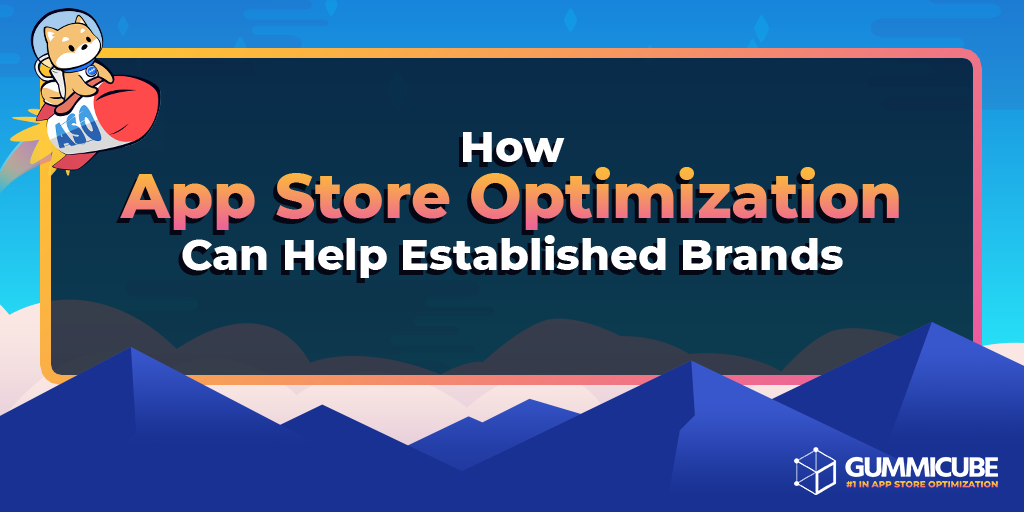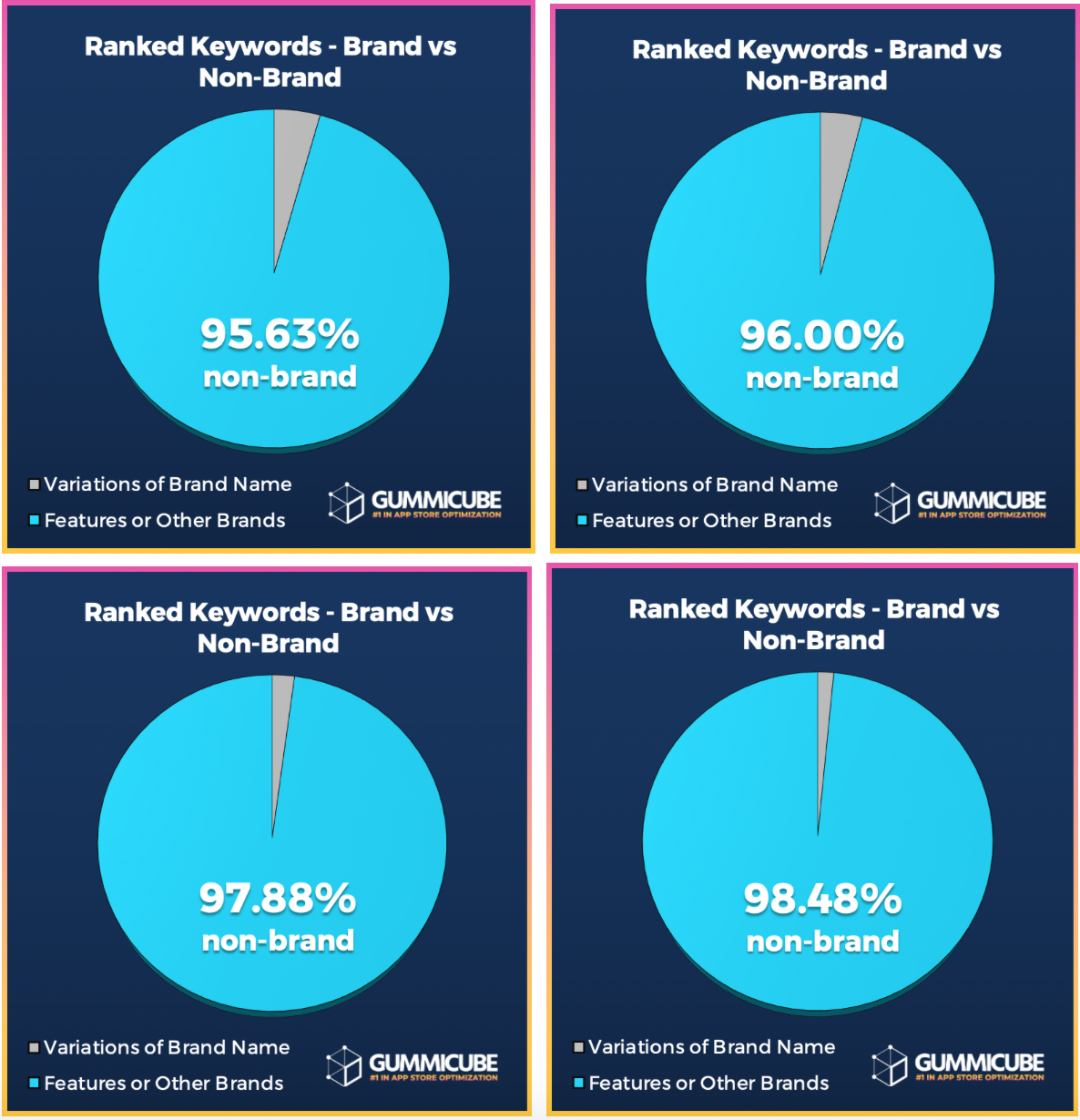How App Store Optimization Can Help Established Brands

This guest-post is courtesy of our partners at Gummicube.
Can a brand name be strong enough to carry its entire app marketing efforts? While many brands are household names, having an established brand does not automatically translate to a successful app in the App Store and Google Play Store. ASO (App Store Optimization) is an essential strategy that must be utilized by anyone looking to market their app, whether coming from a new startup or a big brand.
Brands and Discoverability
Even if a brand is well-established, it can miss out on a huge percentage of its potential downloads by not having an ASO strategy. Efforts need to be made to identify valuable keywords, build and test creative elements that gain conversions and invest in paid marketing within the app stores to reach that potential.
An analysis of four major brands’ optimized apps on the App Store shows that approximately 95% of the keywords they ranked for are terms unrelated to the brand or developer name. This means that an optimization strategy focused solely around a brand neglects the vast majority of users who could discover it.

Above: examples of optimized apps that rank for thousands of keywords. Terms unrelated to their app’s name, their developer name and variations of those make up a small portion of their overall keyword reach.
Targeting a variety of search terms provides app developers with an opportunity to reach a relevant user base that they might not be targeting. Relying on your brand alone can mean missing out on these opportunities.
Brands in Action
An analysis of two familiar brands illustrates how apps can utilize non-branded terms to reach a wider audience or fall behind their competitors by neglecting feature-focused keywords.
With Taco Bell, for instance, one would think its name recognition would help it appear high in the results for any relevant search. Yet while its competitors rank well for terms like “food delivery” and “local food,” Taco Bell comes in at #18 for “food delivery,” and does not rank for “local food” at all. This puts it behind competitor apps from Chipotle, Chick-fil-A and Slice.
On the other hand, there are brands that have leveraged high volume search terms related to their business to improve their visibility on the App Store. Walmart ranks #2 for “medications,” as well as #4 for “grocery store apps.” This stands as an example of how a brand can leverage ASO to rank for high volume search terms related to its business, adding to the downloads its brand can help it achieve rather than relying on that alone.
How ASO Can Help
Since a brand alone won’t provide the maximum discoverability, how can you reach more users?
Ask yourself: Is your app reaching its full potential market? Are you ranking high for every keyword related to your app, or just your brand? There is always room for improvement, and ASO can help with that.
App Store Optimization is a mobile app marketing strategy that improves all aspects of the marketing funnel, including organic visibility and conversion from paid channels. ASO can help increase the efficiency of all the traffic leading to your app so you don’t have to rely on your name recognition to do all the heavy lifting. This includes:
– Keyword optimization, which can effectively increase overall visibility and keyword rankings
– Designing and A/B testing creative elements to increase downloads and improve the yield on overall traffic
– Paid marketing strategies to supplement organic growth and improve conversion from paid UA efforts
A change in one area can impact the success of the others. With proper research and optimization strategies, you can extend your reach to relevant user bases.
Why ASO Matters for Brands
ASO can help app developers reach users by improving visibility where users are most likely to find their apps. In 2017, Apple announced that approximately 70% of mobile app downloads come from searching the app stores. This statistic still holds true today. Since ASO increases organic reach, it is a valuable means for increasing installs.
Keyword Targeting
One of your first goals should be to increase the number of keywords your app can rank for. The App Store and Play Store will merchandise your listing for its keywords and give your app a rank for each of its search terms, so you need to target relevant keywords and phrases to increase visibility.
As an app gains clicks from a search result, the stores find the app more relevant for that search term. This increases its ranking for the keywords that convert, thus helping it reach more potential users.
What this means for brands is that they can target users that might not be searching for your app specifically. Going back to Walmart, a user may be searching for apps to help them when they shop at grocery stores. Due to Walmart’s keyword optimization, that user will see the Walmart app early on in the search results, even if they weren’t looking for Walmart in particular.
App developers should optimize for the high volume, feature-based terms related to their business. If they have competitors on the app stores, they can research what keywords the competition is targeting to see if it’s suited for their app. Consider how well the keyword could relate to the app and if it would be a valuable one to target based on your features, then adjust your screenshots to highlight the terms. The app will retain its ranking for its own brand and terms while expanding to reach an even wider audience.
Creative Optimization
When a user sees your app, they still have to make the decision to install it. Optimizing for user conversion is key to attaining downloads. This means designing creative sets, including icons and screenshots, that users respond well to.
These creatives can and should utilize branding elements. At the same time, developers must be careful about solely relying on them. Will using the brand’s logo as an icon reach users most efficiently, or should the icon integrate iconography relevant to the app? Developers need to test these variations to discover what works best.
Creatives on the App Store and Play Store should display key features of the app while incorporating branded aspects. Keep in mind that what works in external marketing such as advertisements may not be as effective on the App Store and Play Store, due to how the apps are displayed; you need to test and evaluate what works best for the stores.
Developers can find the best balance by running A/B tests that compare variations, such as different imagery, messages or color schemes. Each test can build upon the success of previous builds to achieve the best possible conversion rate.
If the app icon needs to be adjusted, the screenshot copy should include features, or the screenshots should display certain UI elements, testing will help developers find what works best. Understanding how creatives impact user conversion can help increase installs.
Overall
Can an app succeed on its brand name alone? Even if an app has successful brand recognition, that alone will not net its maximum potential downloads. Relying on the brand may not convey the full features and services the app can provide, thus ignoring potential opportunities to gain downloads. There are still many more search terms it could rank for and users it could reach.
Optimizing can help an app appear in more searches and gain more downloads. From the smallest of indie startups to the largest of brand names, App Store Optimization can help give an app the visibility and reach it needs to gain more users.
About the Author
Gummicube Co-Founder & CEO, Dave Bell
Gummicube is a global leader in App Store Optimization with more than 11 years of experience optimizing and marketing apps. We offer the leading enterprise ASO technology and agency services, providing support to clients around the world. Our company is trusted by thousands of enterprise brands and leading startups including Microsoft, LinkedIn, Bethesda, SWEAT, GrubHub, McAfee and many others.
Subscribe to our newsletter!
Get the latest up-to-date news on all things MEDL.
This site is protected by reCAPTCHA and the Google Privacy Policy and Terms of Service apply.

Hyper-Personalized Political Campaigns
Five Contactless Business Solutions
